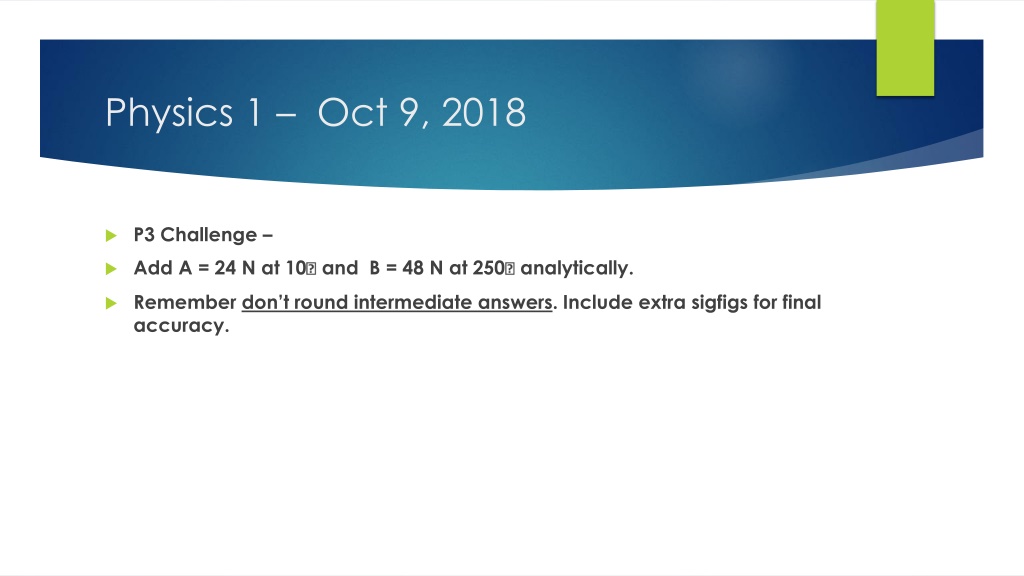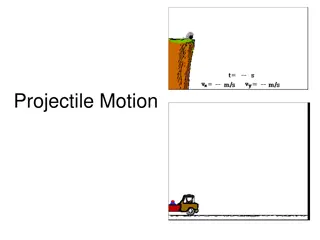Understanding 2D Kinematics and Projectile Motion in Physics
Explore the principles of 2D motion in physics, including vector quantities, kinematic equations, and problem-solving techniques. Dive into projectile motion, understanding its components and variables, and how to analyze trajectories. Enhance your knowledge through practical examples and challenges.
Download Presentation

Please find below an Image/Link to download the presentation.
The content on the website is provided AS IS for your information and personal use only. It may not be sold, licensed, or shared on other websites without obtaining consent from the author. Download presentation by click this link. If you encounter any issues during the download, it is possible that the publisher has removed the file from their server.
E N D
Presentation Transcript
Physics 1 Oct 9, 2018 P3 Challenge Add A = 24 N at 10 and B = 48 N at 250 analytically. Remember don t round intermediate answers. Include extra sigfigs for final accuracy.
Objectives, Agenda, Assignment IB 2.1 Motion 2D Motion Agenda 2D motion in general Projectile motion Range Assignment: Projectile Motion Practice Worksheet
Two dimensional kinematics Recall that 4 out of the 5 kinematics quantities are vectors: displacement, initial velocity, final velocity, and acceleration. In describing 2D motion, these same 5 variables are used. While these quantities may be provided or asked for in terms of their magnitude and direction, when doing an analysis of 2D motion, one.. separates each into their x and y components. lets t be the same for both dimensions because it is a scalar. applies 1D kinematic equations to each dimension independently. recombines the components of any given vector quantity as needed.
2D kinematics problem solving Generally, (not commonly) you will make two lists of the five kinematics variables, using subscripts of x or y to indicate which dimension you are referring to. Let t be the same variable for both dimensions. As always, if you know three pieces of information in a single dimension, you can completely solve the motion in that dimension. Ex: An electron in a cathode ray tube is traveling horizontally at 2.1 x 109 cm/s when deflection plates give it an upward acceleration of 5.30 x 1017 cm/s2. a) How long does it take for the electron to cover a horizontal distance of 6.20 cm? b) What is its vertical displacement during this time?
Projectile motion Projectile motion occurs anytime an object is moving freely through space within a plane of motion. (i.e. not curving into 3D) Projectile motion gets split into its x and y dimensions. In the x dimension, there is no acceleration and a constant vx. x = vxt is the only equation. In the y dimension, there is freefall motion with all of its special cases and variations and facts. The resulting trajectory when both dimension operate at the same time is a parabola.
Variables for all projectile motion Variables to use: x = vx= t = y = uy= vy= a = t = x and yare the components of the displacement. vxand uyare the components of the initial velocity. vxand vyare the components of the final velocity. a = ay= 9.81 m/s2 t is the same for each dimension. Connects the dimensions.
Horizontal launch If a projectile has a horizontal launch, its vxwill equal its initial velocity magnitude and the vertical component of the initial velocity = 0. Ex: A mountain climber encounters a crevasse in an ice field. The opposite side of the gap is 2.75 m lower and is separated horizontally by a distance of 4.10 m. To cross the crevasse, she gets a running start and jumps in the horizontal direction. What is the minimum speed needed to safely land on the other side?
Practice problems An archer aims his arrow horizontally at the bullseye of a target 15.0 m away. If his initial arrow speed is 22.3 m/s, by how much does he miss the target and in what direction is his error? A plane traveling at 115 m/s needs to drop relief supplies to refugees below. If the pane is at an altitude of 435 m, how far horizontally from the landing site should the pilot open the cargo doors?
Launch at an angle Ex: You throw a ball from a cliff with an initial velocity of 15.0 m/s at an angle of 20 degrees above the horizontal. Find a) its horizontal displacement and b) its vertical displacement 2.30 seconds later. Repeat the problem if the launch angle was 20 degrees below the horizontal.
Range Equation IF you have a complete level trajectory, you can determine the relationship between the range and the launch angle from the Range equation. ? =?? ???? ?? Notice that the maximum range will be obtained when the launch angle is 45 degrees. For any range less than the maximum, there will be two possible launch angles resulting in a high and low trajectory. Ex: At what possible angles does a punt kicker need to launch a football from his foot at the ground to reach a receiver diving for it at the ground at 28.0 meters away if his kick generates an initial ball speed of 13.5 m/s?
Exit Slip - Assignment What quantity is zero at the top of a projectile trajectory? What s Due on Thurs Oct 11? (Pending assignments to complete.) Projectile Motion Practice Worksheet What s Next? (How to prepare for the next day) Read p45-50























